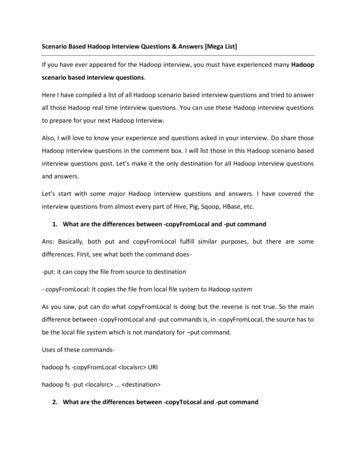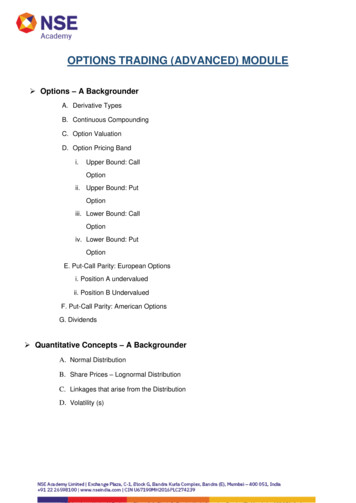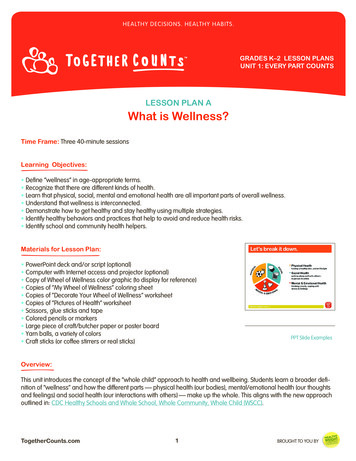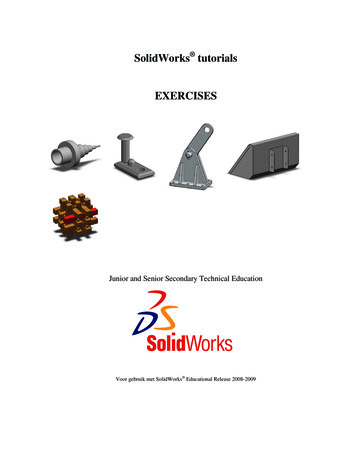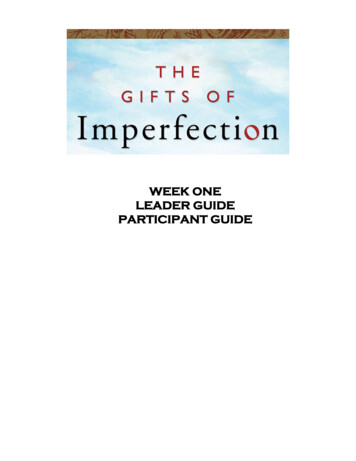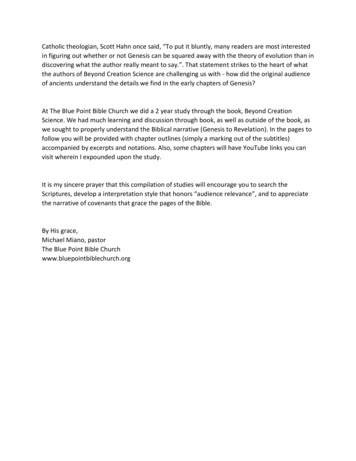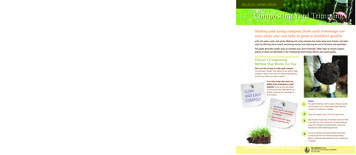
Transcription
BELLEVUE: GOING GREENComposting Yard TrimmingsGreensFresh grass clippingsClippings recently treated with herbicide.Put in curbside green yard debris cart.Fresh garden trimmings,flowers and plant leavesInsect infested or diseased plants.Put in curbside green yard debris cart.Barnyard manure (horse, cow,Pet Wastes — (dog, cat, rodent, exoticbird).chicken, rabbit)bird). Bag and put into curbside graygarbage cart.Garden vegetable leaves and stalksproducts, fruit,Food Scraps—meat , fish, poultry, dairy,fruit, cooked vegetables. Put these itemsinto curbside green yard debris cart.Weed leaves and flowersWeed seed heads. Roots of spreadingweeds like ivy, morning glory andquack grass. Put in curbside green yarddebris cart.House plants and potting mixBrownsAutumn leavesInsect infested or diseased plants.Put in curbside green yard debris cart.Large amounts of evergreen leaves.Put in curbside green yard debris cart oruse to mulch paths.Twigs and stalksBranches over 1/2” diameter. Berrybrambles and other thorny stems.Put in curbside green yard debris cart.Sawdust or shavingsSawdust from plywood, treated orpainted wood. Put in curbside graygarbage cart.Shredded paper, cardboard,paper towelsWhy make and use your own compost when youcan use Bellevue’s convenient yard and food wastecollection program and buy the finished Cedar GroveCompost at local stores? The information below willhelp you compare the benefits of both.Home CompostingFree compost!No energy used to transport and process.Cooler compost process may preserve nutrients andbeneficial soil life.Coarse materials in finished compost helps aerate soil.Don’t need to go to store to buy compost.Curbside Collection / Purchase CompostFree bin, no work required!Best for composting branchesover 1/2 inch diameter andevergreen leaves.Hot composting destroysweed seeds and roots.Uniform, fine composteasy to spread and looks asgood as mulch.As much compost as youneed, ready when youneed it.with less water, work, and waste. Making and using compost also helps keep local streams and lakesclean by filtering storm runoff, preventing erosion and reducing the use of fertilizer and pesticides.This guide describes simple ways to compost your yard trimmings. Other ways to recycle organicwastes at home are described in the Composting Food Scraps, Mulch, and Lawns guides.Choose a CompostingMethod That Works for YouThere are lots of ways to make good compost.The two basic “recipes” that follow can be used to makecompost in piles or bins. Use the method that matchesthe time and effort you want to spend.SLOWAND EASYCOMPOSTA no-fuss recipe that works byadding fresh trimmings in smallamounts to pile as they are pickedup around the yard. Materials at thebottom of pile will be composted in6-12 months.IngredienFresh “ ts:green”and wo“brownody”yas avail ard trimmings,ableWater(hose withead or water h spraying can)Glossy coated paper. Put in curbsideblue recycling cart.1Put yard trimmings in bin or pile as they are pickedup from yard. Cut or chop woody stalks. Mix andmoisten dry materials as needed.2Cover with plastic, soil, or bin lid to keep moist.3Dig into pile occasionally. If materials that have beenin the pile for a few months are not decomposing,check the “Compost Troubleshooting” chart thatfollows and make needed adjustments.4In 6 to 12 months, pull aside freshest trimmingson top to harvest the finished compost below.Return undecomposed materials to bin, moisteningif needed.FBE LWASHINGTVUELENATURAL GARDENING GUIDESSteps:Nin piles or bins.ODo Not CompostMaking and using compost from yard trimmings areeasy steps you can take to grow a healthier gardenOin piles or bins.BATTLE OF THE BINS:BACKYARD COMPOSTING VS.“CLEAN GREEN COLLECTION”CITYWhat Can Be Put in aHome Yard Waste Compost?Do CompostBELLEVUE: GOING GREENCity of Bellevue Utilities450 110th Avenue NE, Bellevue, WA 98004425-452-6932
BELLEVUE: GOING GREENNATURAL GARDENING GUIDESBE LINGTCITYIngredients:ials to make aEnough mater.or to fill a bin3’ x 3’ x 3’ pileswheelbarrowSeveral largeen”re“gof freshor trash cansgsyard trimminswheelbarrowSeveral large”nwof “broor trash cansgin syard trimmWaterray head)(hose with spA recipe madein large batchesthat are ready touse in 2-3 months.Make a Pile—or Pick a Bin12Put roughly equal parts “greens” and “browns”on a tarp.3Spray materials with water and mix with gardenfork until all glisten with moisture.4Load mix into bin or stack in pile. Repeat until binis full or all materials are mixed.5Monitor the heat in middle of the pile using acompost thermometer or by touch. Turn pilewhen it has heated and starts to cool (5-7 days),placing materials from the outside edges intothe middle of new pile. Moisten dry materialsas turning. If pile has not heated up check“Compost Troubleshooting” chart.6Turn pile again in 5-7 days and monitor.Cover with plastic or carpet scrap andlet age 4-8 weeks until dark andsweet smelling, like soil.City of Bellevue Utilities450 110th Avenue NE, Bellevue, WA 98004425-452-6932A Diet forQuicker Compost“Browns”Piles (above) are the simplest way to compost.However, open piles are easily disturbed by pets orpests, and may dry out—which slows composting.Turning Systems (below) are designed for quickcomposting of large volumes. They can be a series ofbins, or rotating barrels mounted on frames. A varietyof barrel systems are offered by mail order suppliers.“Greens”Plastic holding binSymptomsWire holding binCause SolutionSmells likerotten eggs or garbage.Pile too wet.Pile is dryinside.Leaf mulch andgrass clippingsTurning system bin photo (above) courtesyKitsap County Solid Waste Division.Turn pile and add dry stalks, leaves,or straw.Food or pet waste in pile.Keep food scraps and pet waste out.Not enough water.Turn, moisten, and cover pile.Too much woody material.Mulching and Grasscycling (left)are also great ways to reuse yardtrimmings. See the Mulch andLawns guides for details.needed, though high nitrogen fertilizers such as bloodmeal or urea help if a pile has too many “browns.”Should I add soil or finished compost? A layer ofsoil or finished compost on top of a pile can help keep itmoist, but is not necessary.Why can’t I compost food scraps with yardtrimmings? Food scraps—especially meat, fish, and dairyYard Waste Compost TroubleshootingHolding Bins (next page, top) neatly containcomposting materials, deter pests, and keep in moisture.Many types are available from stores and mail-ordercatalogs; or they can be made from wood pallets,hardware cloth, cement blocks, or other materials.WHATABOUT . . . ?Do I need to add compost “starters,” fertilizer,or limestone? Nothing but yard trimmings is usuallyNaturally occurring bugs, microorganisms, and fungiwill decompose yard trimmings left in the garden orplaced in a compost pile—but it may take a year or more.Helping these decomposers with an optimal diet canreduce composting time to just a few months.Steps:Cut or shred woody stalks with a pruner,machete, shovel, lawn mower, or shredder/chipper.NWQUICKAND HOTCOMPOSTOOFSHVUELEAPile too small.Pile is dampMix in greens or fertilizer. Chop orremove coarse woody materials.Add greens and browns.inside, but notLack of greens.composting.Mix in greens or nitrogen fertilizer.Remove excess woody material.Pile has shrunken,but looks undecomposed.Outside of pile dry—inside may be composted.Check in pile for finished compost. Useundecomposed material in new batch.Clumps of slimy grass,Too much fresh grass.ammonia smell.Leave clippings on lawn, or mix inbrown leaves or straw.A Mix of “Greens” and “Browns.” Decomposersthrive on an equal mix of succulent “greens” like freshgrass clippings, weed leaves, and flowers; and woodier“browns” such as autumn leaves and stalks. Too many“greens” make a smelly mess. A pile that is too “brown”decomposes very slowly. Use the list of greens andbrowns that follows to create a healthy balance.Small Pieces. Small bits decompose faster than largechunks. To speed composting, chop woody stalks andtwigs with a shovel or machete, or run them over witha lawn mower or through a shredder.Ample Moisture. Materials should be moist but notdripping wet—like a wrung out sponge. Spray and mixdry trimmings as they are added to a compost pile orwhen turning a dry pile. Compost in the shade and coverpiles with plastic to hold moisture.Fresh Air. If materials are too wet or compacted,composting will be slow and stinky. A good mix includingsome coarse stalks allows air into the pile. Turn soggy,smelly piles and mix in dry straw to let air in.Large Pile. One cubic yard (3’ tall, 3’ wide and 3’ long)is an ideal pile size. Smaller piles dry out quickly, thoughbins with solid sides help. Larger piles need to be turnedoften to let air into the middle.products—create bad smells and attract rats, flies, dogs,raccoons, and other pests. The Composting Food Scrapsguide explains safe ways to compost grains, fruits, andvegetable scraps using systems that contain odors anddeter pests. Meat and other animal scraps should not becomposted at home. Put these items in curbside greenyard debris cart.What can I do if I mostly have grass clippings tocompost? The best option is to leave grass clippings onthe lawn. See the Lawn guide for details. When you mustcollect grass clippings, spread them as a thin (1/2 inch)mulch on garden beds, or mix them with straw or brownleaves saved from autumn to compost.Can I compost pet wastes? No! Dog, cat, and other petfeces can transmit diseases to people. Bag it and put intocurbside gray garbage cart. Chicken, horse, and rabbitmanures may be composted and are a good source of“greens.”
BELLEVUE: GOING GREENUtilitiesIngredients:ials to make aEnough mater.or to fill a bin3’ x 3’ x 3’ pileswheelbarrowSeveral largeen”re“gof freshor trash cansgsyard trimminswheelbarrowSeveral large”nwof “broor trash cansgin syard trimmWaterray head)(hose with spQUICKAND HOTCOMPOST234Do I need to add compost “starters,” fertilizer,or limestone? Nothing but yard trimmings is usuallyneeded, though high nitrogen fertilizers such as bloodmeal or urea help if a pile has too many “browns.”Should I add soil or finished compost? A layer ofsoil or finished compost on top of a pile can help keep itmoist, but is not necessary.A recipe madein large batchesthat are ready touse in 2-3 months.Why can’t I compost food scraps with yardtrimmings? Food scraps—especially meat, fish, and dairyPlastic holding binSteps:1Cut or shred woody stalks with a pruner,Wire holding binCause SolutionSmells likerotten eggs or garbage.Pile too wet.on a tarp.products—create bad smells and attract rats, flies, dogs,raccoons, and other pests. The Composting Food Scrapsguide explains safe ways to compost grains, fruits, andvegetable scraps using systems that contain odors anddeter pests. Meat and other animal scraps should not becomposted at home. Put these items in curbside greenyard debris cart.Yard Waste Compost TroubleshootingSymptomsTurn pile and add dry stalks, leaves,or straw.Pile is dryinside.Not enough water.Turn, moisten, and cover pile.Can I compost pet wastes? No! Dog, cat, and other petMix in greens or fertilizer. Chop orremove coarse woody materials.feces can transmit diseases to people. Bag it and put intocurbside gray garbage cart. Chicken, horse, and rabbitmanures may be composted and are a good source of“greens.”Too much woody material.Pile too small.Turn pile again in 5-7 days and monitor.Cover with plastic or carpet scrap andlet age 4-8 weeks until dark andsweet smelling, like soil.Leaf mulch andgrass clippingsPile is dampAdd greens and browns.inside, but notLack of greens.composting.Mix in greens or nitrogen fertilizer.Remove excess woody material.Pile has shrunken,but looks undecomposed.Outside of pile dry—inside may be composted.Check in pile for finished compost. Useundecomposed material in new batch.Clumps of slimy grass,Too much fresh grass.ammonia smell.the lawn. See the Lawn guide for details. When you mustcollect grass clippings, spread them as a thin (1/2 inch)mulch on garden beds, or mix them with straw or brownleaves saved from autumn to compost.Keep food scraps and pet waste out.is full or all materials are mixed.as turning. If pile has not heated up check“Compost Troubleshooting” chart.What can I do if I mostly have grass clippings tocompost? The best option is to leave grass clippings onFood or pet waste in pile.fork until all glisten with moisture.56WHATABOUT . . . ?Leave clippings on lawn, or mix inbrown leaves or straw.
BELLEVUE: GOING GREENNATURAL GARDENING GUIDESBE LINGTCITYIngredients:ials to make aEnough mater.or to fill a bin3’ x 3’ x 3’ pileswheelbarrowSeveral largeen”re“gof freshor trash cansgsyard trimminswheelbarrowSeveral large”nwof “broor trash cansgin syard trimmWaterray head)(hose with spA recipe madein large batchesthat are ready touse in 2-3 months.Make a Pile—or Pick a Bin12Put roughly equal parts “greens” and “browns”on a tarp.3Spray materials with water and mix with gardenfork until all glisten with moisture.4Load mix into bin or stack in pile. Repeat until binis full or all materials are mixed.5Monitor the heat in middle of the pile using acompost thermometer or by touch. Turn pilewhen it has heated and starts to cool (5-7 days),placing materials from the outside edges intothe middle of new pile. Moisten dry materialsas turning. If pile has not heated up check“Compost Troubleshooting” chart.6Turn pile again in 5-7 days and monitor.Cover with plastic or carpet scrap andlet age 4-8 weeks until dark andsweet smelling, like soil.City of Bellevue Utilities450 110th Avenue NE, Bellevue, WA 98004425-452-6932A Diet forQuicker Compost“Browns”Piles (above) are the simplest way to compost.However, open piles are easily disturbed by pets orpests, and may dry out—which slows composting.Turning Systems (below) are designed for quickcomposting of large volumes. They can be a series ofbins, or rotating barrels mounted on frames. A varietyof barrel systems are offered by mail order suppliers.“Greens”Plastic holding binCauseSmells likeLeaf mulch andgrass clippingsTurning system bin photo (above) courtesyKitsap County Solid Waste Division.A Mix of “Greens” and “Browns.” Decomposersthrive on an equal mix of succulent “greens” like freshgrass clippings, weed leaves, and flowers; and woodier“browns” such as autumn leaves and stalks. Too many“greens” make a smelly mess. A pile that is too “brown”decomposes very slowly. Use the list of greens andbrowns that follows to create a healthy balance.rotten eggs or garbage.Small Pieces. Small bits decompose faster than largechunks. To speed composting, chop woody stalks andtwigs with a shovel or machete, or run them over witha lawn mower or through a shredder.Pile is dryAmple Moisture. Materials should be moist but notdripping wet—like a wrung out sponge. Spray and mixdry trimmings as they are added to a compost pile orwhen turning a dry pile. Compost in the shade and coverpiles with plastic to hold moisture.inside.Mulching and Grasscycling (left)are also great ways to reuse yardtrimmings. See the Mulch andLawns guides for details.needed, though high nitrogen fertilizers such as bloodmeal or urea help if a pile has too many “browns.”Should I add soil or finished compost? A layer ofsoil or finished compost on top of a pile can help keep itmoist, but is not necessary.Why can’t I compost food scraps with yardtrimmings? Food scraps—especially meat, fish, and dairySymptomsHolding Bins (next page, top) neatly containcomposting materials, deter pests, and keep in moisture.Many types are available from stores and mail-ordercatalogs; or they can be made from wood pallets,hardware cloth, cement blocks, or other materials.WHATABOUT . . . ?Do I need to add compost “starters,” fertilizer,or limestone? Nothing but yard trimmings is usuallyNaturally occurring bugs, microorganisms, and fungiwill decompose yard trimmings left in the garden orplaced in a compost pile—but it may take a year or more.Helping these decomposers with an optimal diet canreduce composting time to just a few months.Steps:Cut or shred woody stalks with a pruner,machete, shovel, lawn mower, or shredder/chipper.NWQUICKAND HOTCOMPOSTOOFSHVUELEAPile is dampcomposting.inside, but notPile has shrunken,but looks undecomposed.Clumps of slimy grass,ammonia smell.Fresh Air. If materials are too wet or compacted,composting will be slow and stinky. A good mix includingsome coarse stalks allows air into the pile. Turn soggy,smelly piles and mix in dry straw to let air in.Large Pile. One cubic yard (3’ tall, 3’ wide and 3’ long)is an ideal pile size. Smaller piles dry out quickly, thoughbins with solid sides help. Larger piles need to be turnedoften to let air into the middle.products—create bad smells and attract rats, flies, dogs,raccoons, and other pests. The Composting Food Scrapsguide explains safe ways to compost grains, fruits, andvegetable scraps using systems that contain odors anddeter pests. Meat and other animal scraps should not becomposted at home. Put these items in curbside greenyard debris cart.What can I do if I mostly have grass clippings tocompost? The best option is to leave grass clippings onthe lawn. See the Lawn guide for details. When you mustcollect grass clippings, spread them as a thin (1/2 inch)mulch on garden beds, or mix them with straw or brownleaves saved from autumn to compost.Can I compost pet wastes? No! Dog, cat, and other petfeces can transmit diseases to people. Bag it and put intocurbside gray garbage cart. Chicken, horse, and rabbitmanures may be composted and are a good source of“greens.”
BELLEVUE: GOING GREENComposting Yard TrimmingsWhat Can Be Put in aHome Yard Waste Compost?RESOURCESBarnyard manure (horse, cow,Pet Wastes — (dog, cat, rodent, exoticbird).chicken, rabbit)bird). Bag and put into curbside graygarbage cart.Garden vegetable leaves and stalksproducts, fruit,Food Scraps—meat , fish, poultry, dairy,fruit, cooked vegetables. Put these itemsinto curbside green yard debris cart.Weed leaves and flowersWeed seed heads. Roots of spreadingweeds like ivy, morning glory andquack grass. Put in curbside green yarddebris cart.House plants and potting mixBrownsAutumn leavesInsect infested or diseased plants.Put in curbside green yard debris cart.Large amounts of evergreen leaves.Put in curbside green yard debris cart oruse to mulch paths.Twigs and stalksBranches over 1/2” diameter. Berrybrambles and other thorny stems.Put in curbside green yard debris cart.No energy used to transport and process.Cooler compost process may preserve nutrients andbeneficial soil life.Coarse materials in finished compost helps aerate soil.Don’t need to go to store to buy compost.Curbside Collection / Purchase CompostFree bin, no work required!Best for composting branchesover 1/2 inch diameter andevergreen leaves.There are lots of ways to make good compost.The two basic “recipes” that follow can be used to makecompost in piles or bins. Use the method that matchesthe time and effort you want to spend.The Garden Hotlinewww.gardenhotline.org or 206-633-0224Grow Smart, Grow Safewww.growsmartgrowsafe.orgNatural Yard Care Neighborhoodswww.naturalyardcare.infoHot composting destroysweed seeds and roots.Uniform, fine composteasy to spread and looks asgood as mulch.As much compost as youneed, ready when youneed it.Choose a CompostingMethod That Works for YouKing County Master Gardener Lake Hills GreenbeltUrban Demonstration Garden at 15500 SE 16th Street,Bellevue.Produced by the City of Bellevue withfunding from:FBE LASHINGTVUELEShredded paper, cardboard,paper towelsFree compost!King County Solid Waste Division’s compostingwebsite are/compost.aspWSawdust or shavingsSawdust from plywood, treated orpainted wood. Put in curbside graygarbage cart.Home CompostingSLOWAND EASYCOMPOSTA no-fuss recipe that works byadding fresh trimmings in smallamounts to pile as they are pickedup around the yard. Materials at thebottom of pile will be composted in6-12 months.IngredienFresh “ ts:green”and wo“brownody”yas avail ard trimmings,ableWater(hose withead or water h spraying can)Steps:1Put yard trimmings in bin or pile as they are pickedup from yard. Cut or chop woody stalks. Mix andmoisten dry materials as needed.2Cover with plastic, soil, or bin lid to keep moist.3Dig into pile occasionally. If materials that have beenin the pile for a few months are not decomposing,check the “Compost Troubleshooting” chart thatfollows and make needed adjustments.Glossy coated paper. Put in curbsideblue recycling cart.4In 6 to 12 months, pull aside freshest trimmingson top to harvest the finished compost below.Return undecomposed materials to bin, moisteningif needed.Alternate formats available: Voice 425-452-6800 or TTY relay: 711.FBE LASHINGTVUELENATURAL GARDENING GUIDESWPrinted on 100% post-consumer recycled-content paper.12/2016NInsect infested or diseased plants.Put in curbside green yard debris cart.OFresh garden trimmings,flowers and plant leavesThis guide describes simple ways to compost your yard trimmings. Other ways to recycle organicwastes at home are described in the Composting Food Scraps, Mulch, and Lawns guides.OFresh grass clippingsClippings recently treated with herbicide.Put in curbside green yard debris cart.with less water, work, and waste. Making and using compost also helps keep local streams and lakesclean by filtering storm runoff, preventing erosion and reducing the use of fertilizer and pesticides.CITYGreensWhy make and use your own compost when youcan use Bellevue’s convenient yard and food wastecollection program and buy the finished Cedar GroveCompost at local stores? The information below willhelp you compare the benefits of both.Bellevue’s Natural Gardening GuidesComposting Food Scraps Composting Yard Trimmings Drip and Soak Fertilizer Garden Design LawnAlternatives Lawns Mulch Pests, Weeds, and Diseases Plant Right Seasonal Calendar Soil WateringFor copies, visit Bellevue’s Natural Lawn and Gardenwebsite (above) or call Bellevue Utilities at 425-452-6932.Nin piles or bins.Making and using compost from yard trimmings areeasy steps you can take to grow a healthier gardenODo Not CompostBellevue’s Natural Lawn and Garden websitewww.bellevuewa.gov/naturalyardcare.htmOin piles or bins.BATTLE OF THE BINS:BACKYARD COMPOSTING VS.“CLEAN GREEN COLLECTION”CITYDo CompostBELLEVUE: GOING GREENCity of Bellevue Utilities450 110th Avenue NE, Bellevue, WA 98004425-452-6932
BELLEVUE: GOING GREENComposting Yard TrimmingsWhat Can Be Put in aHome Yard Waste Compost?RESOURCESBarnyard manure (horse, cow,Pet Wastes — (dog, cat, rodent, exoticbird).chicken, rabbit)bird). Bag and put into curbside graygarbage cart.Garden vegetable leaves and stalksproducts, fruit,Food Scraps—meat , fish, poultry, dairy,fruit, cooked vegetables. Put these itemsinto curbside green yard debris cart.Weed leaves and flowersWeed seed heads. Roots of spreadingweeds like ivy, morning glory andquack grass. Put in curbside green yarddebris cart.House plants and potting mixBrownsAutumn leavesInsect infested or diseased plants.Put in curbside green yard debris cart.Large amounts of evergreen leaves.Put in curbside green yard debris cart oruse to mulch paths.Twigs and stalksBranches over 1/2” diameter. Berrybrambles and other thorny stems.Put in curbside green yard debris cart.No energy used to transport and process.Cooler compost process may preserve nutrients andbeneficial soil life.Coarse materials in finished compost helps aerate soil.Don’t need to go to store to buy compost.Curbside Collection / Purchase CompostFree bin, no work required!Best for composting branchesover 1/2 inch diameter andevergreen leaves.There are lots of ways to make good compost.The two basic “recipes” that follow can be used to makecompost in piles or bins. Use the method that matchesthe time and effort you want to spend.The Garden Hotlinewww.gardenhotline.org or 206-633-0224Grow Smart, Grow Safewww.growsmartgrowsafe.orgNatural Yard Care Neighborhoodswww.naturalyardcare.infoHot composting destroysweed seeds and roots.Uniform, fine composteasy to spread and looks asgood as mulch.As much compost as youneed, ready when youneed it.Choose a CompostingMethod That Works for YouKing County Master Gardener Lake Hills GreenbeltUrban Demonstration Garden at 15500 SE 16th Street,Bellevue.Produced by the City of Bellevue withfunding from:FBE LASHINGTVUELEShredded paper, cardboard,paper towelsFree compost!King County Solid Waste Division’s compostingwebsite are/compost.aspWSawdust or shavingsSawdust from plywood, treated orpainted wood. Put in curbside graygarbage cart.Home CompostingSLOWAND EASYCOMPOSTA no-fuss recipe that works byadding fresh trimmings in smallamounts to pile as they are pickedup around the yard. Materials at thebottom of pile will be composted in6-12 months.IngredienFresh “ ts:green”and wo“brownody”yas avail ard trimmings,ableWater(hose withead or water h spraying can)Steps:1Put yard trimmings in bin or pile as they are pickedup from yard. Cut or chop woody stalks. Mix andmoisten dry materials as needed.2Cover with plastic, soil, or bin lid to keep moist.3Dig into pile occasionally. If materials that have beenin the pile for a few months are not decomposing,check the “Compost Troubleshooting” chart thatfollows and make needed adjustments.Glossy coated paper. Put in curbsideblue recycling cart.4In 6 to 12 months, pull aside freshest trimmingson top to harvest the finished compost below.Return undecomposed materials to bin, moisteningif needed.Alternate formats available: Voice 425-452-6800 or TTY relay: 711.FBE LASHINGTVUELENATURAL GARDENING GUIDESWPrinted on 100% post-consumer recycled-content paper.12/2016NInsect infested or diseased plants.Put in curbside green yard debris cart.OFresh garden trimmings,flowers and plant leavesThis guide describes simple ways to compost your yard trimmings. Other ways to recycle organicwastes at home are described in the Composting Food Scraps, Mulch, and Lawns guides.OFresh grass clippingsClippings recently treated with herbicide.Put in curbside green yard debris cart.with less water, work, and waste. Making and using compost also helps keep local streams and lakesclean by filtering storm runoff, preventing erosion and reducing the use of fertilizer and pesticides.CITYGreensWhy make and use your own compost when youcan use Bellevue’s convenient yard and food wastecollection program and buy the finished Cedar GroveCompost at local stores? The information below willhelp you compare the benefits of both.Bellevue’s Natural Gardening GuidesComposting Food Scraps Composting Yard Trimmings Drip and Soak Fertilizer Garden Design LawnAlternatives Lawns Mulch Pests, Weeds, and Diseases Plant Right Seasonal Calendar Soil WateringFor copies, visit Bellevue’s Natural Lawn and Gardenwebsite (above) or call Bellevue Utilities at 425-452-6932.Nin piles or bins.Making and using compost from yard trimmings areeasy steps you can take to grow a healthier gardenODo Not CompostBellevue’s Natural Lawn and Garden websitewww.bellevuewa.gov/naturalyardcare.htmOin piles or bins.BATTLE OF THE BINS:BACKYARD COMPOSTING VS.“CLEAN GREEN COLLECTION”CITYDo CompostBELLEVUE: GOING GREENCity of Bellevue Utilities450 110th Avenue NE, Bellevue, WA 98004425-452-6932
Free bin, no work required!debris cart. House plants and potting mix Insect infested or diseased plants. Put in curbside green yard debris cart. Browns . Autumn leaves Large amounts of evergreen leaves. Put in curbside green yard debris cart or use to mulch paths. Twigs and stalks Branche
